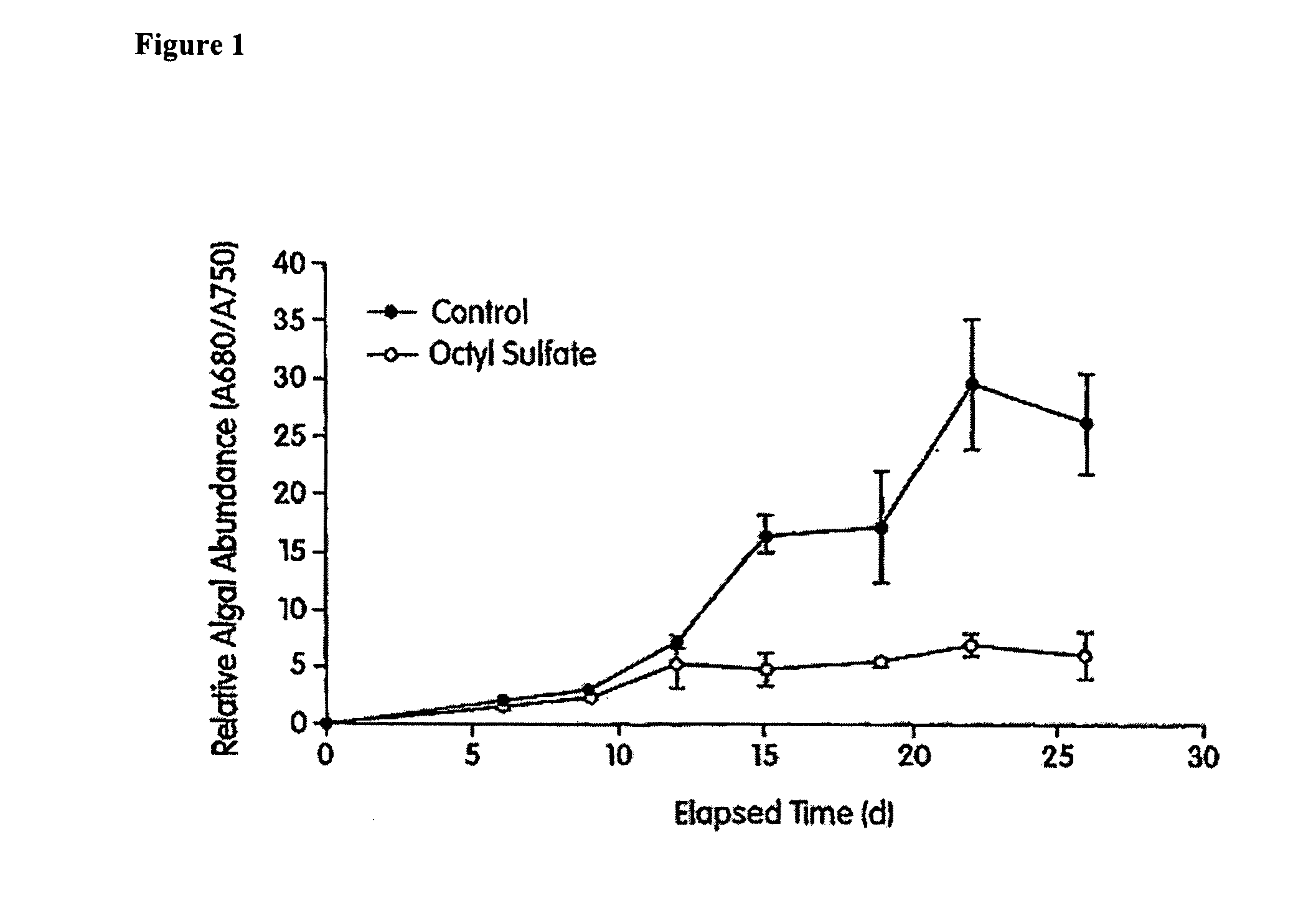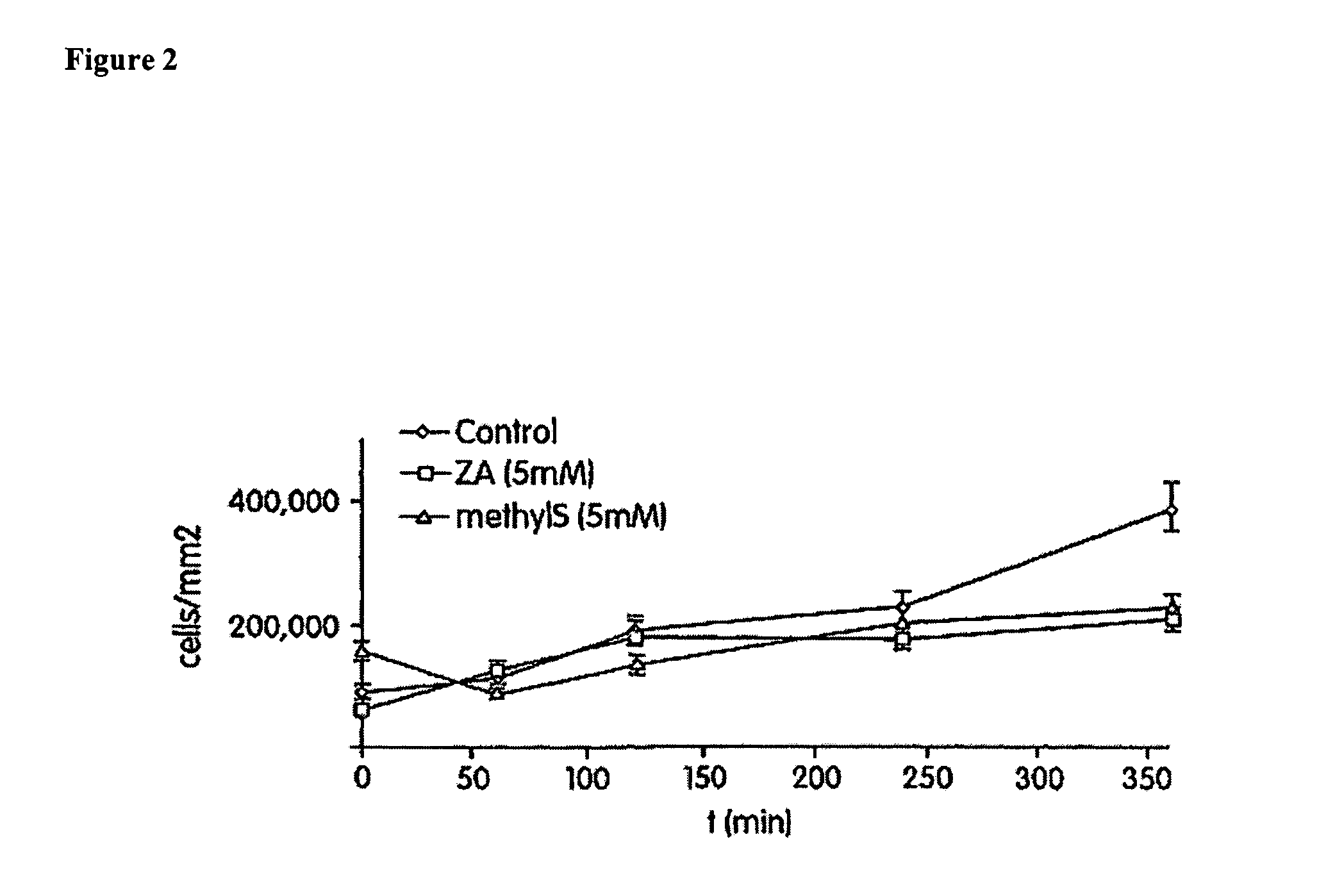Safe and effective biofilm inhibitory compounds and health-related uses thereof
- Summary
- Abstract
- Description
- Claims
- Application Information
AI Technical Summary
Benefits of technology
Problems solved by technology
Method used
Image
Examples
example 1
Inhibition of Surface Attachment of Marine Bacteria by Alkyl Sulfates
[0194]Octyl sulfate is an alkyl sulfate surfactant with extensive industrial applications, and is manufactured by several large chemical companies. To investigate potential AF properties of the sulfate ester octyl sulfate, it was incorporated into an inert coating material that was then coated onto a surface to be exposed to conditions that support the formation of marine algal biofilms.
[0195]Materials and Methods
[0196]A 30% (w / v) solution of octyl sulfate in water (Stepan Chemical Co.) was evaporated to dryness under a stream of room temperature air, to recover pure octyl sulfate (FIG. 1). The dry octyl sulfate was incorporated into RTV-11 silicone polymer at a loading of 25% (wt / wt) (RTV-11 silicone, catalyst and primer obtained from General Electric). The mixture was applied to three glass slides previously primed with silicone primer, and allowed to cure to dryness. Three primed glass slides coated with pure RT...
example 2
Inhibition of Fungal Surface Attachment and Mycelial Development
[0207]To determine the effectiveness of sulfate esters at inhibiting fungal biofouling, the ability of zosteric acid to inhibit attachment of the fungus Aureobasidium pullulans to surfaces was examined.
[0208]Materials and Methods
[0209]Aureobasidium pullulans (ATCC 34261) was grown on potato-dextrose agar and harvested according to ASTM G-21-90 protocols (American Society for Testing and Materials (1986) D1141-86, ASTM, Philadelphia, Pa.). The resulting spore suspension was used to inoculate liquid culture tubes containing 35 mL of growth medium (nutrient salts with 5 mM sucrose) and 15 mM zosteric acid. Zosteric acid-free medium was prepared as a control. A sterile microscope slide was added to each tube, the tubes were sealed and placed on a rotary shaker table at room temperature. One tube was harvested each day by removing the slide and counting the number of attached spores by direct microscopic counts, as described...
example 3
Sulfate Esters Bind Cell Surfaces of Biofouling Organisms
[0212]To investigate the mechanism behind the AF activity of sulfate esters, polyclonal antibodies specific for the sulfate ester zosteric acid were generated (BAbCo, Berkeley, Calif.). Preliminary testing of these antibodies for cross reactivity towards related compounds lacking the sulfate ester group (cinnamic acid, ferulic acid, coumaric acid) showed no cross reactivity, suggesting that the specific domain recognized by the antibodies probably includes the sulfate ester group. These antibodies were then used to investigate whether the sulfate ester AF agent zosteric acid directly binds fouling organisms.
[0213]The marine bacterium Shewanella putrefaciens were grown in cultures containing zosteric acid and were subsequently examined for bound zosteric acid using immuno-gold staining with the antibody described above. Electron microscopic examination of immunoprobed S. putrefaciens detected zosteric acid molecules bound to th...
PUM
| Property | Measurement | Unit |
|---|---|---|
| Volume | aaaaa | aaaaa |
| Volume | aaaaa | aaaaa |
| Volume | aaaaa | aaaaa |
Abstract
Description
Claims
Application Information
 Login to View More
Login to View More - R&D
- Intellectual Property
- Life Sciences
- Materials
- Tech Scout
- Unparalleled Data Quality
- Higher Quality Content
- 60% Fewer Hallucinations
Browse by: Latest US Patents, China's latest patents, Technical Efficacy Thesaurus, Application Domain, Technology Topic, Popular Technical Reports.
© 2025 PatSnap. All rights reserved.Legal|Privacy policy|Modern Slavery Act Transparency Statement|Sitemap|About US| Contact US: help@patsnap.com



